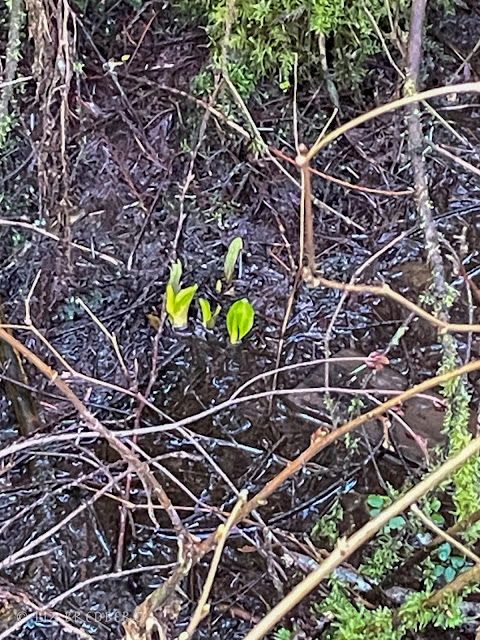17 March
Gradually, spring is making its way into the Forest and Wetlands. The frogs were in full voice this morning, celebrating the change of the season. https://drive.google.com/file/d/1kEgrY6-12eF-hQS9O2krJc-B62u7uAg-/view?usp=sharing
It was, finally, a sunny morning, and the forest is becoming increasingly lush. Skunk cabbage shoots are just appearing.
A variety of mosses are emerging, some of which we hadn't seen before. We'll hope for identification.
We've only seen the moss below in one spot. It seems uncommon for this area; it will be worth monitoring its development as well as submitting it to iNaturalist.
There were a couple of patches of birds-nest fungus among the mosses.
I've observed the branches of this conifer before, thinking it was a western hemlock, but looking for the parent tree or cones to confirm my identification.
Today I realised that it is actually an entire young tree, with the central trunk emerging from the fallen tree that is visible across the bottom of the photo. Reading up western hemlock in Pojar and MacKinnon, I see that it has a propensity for rooting in fallen trees. (I've seen this in areas where hemlock is more common.) Its scientific name, Tsuga heterophylla (a mixture of Japanese--Tsuga--tree and the stem for mother--and Greek--heterophylla--differing leaves) helps with the identification. Or at least the heterophylla, does--the leaves vary in size in a way unlike most conifers. It will be interesting to watch as it matures.
In addition to maturation as a change agent in the forest, disintegration can drive change.
The woodpecker stump continues to shrink...
...and the mossy muppet has all but lost its identity as the log disintegrates and the moss grows.
It looks as though a very small huckleberry vine is starting on his jaw.
Unfortunately, the dock continues without its final segment and its bench. We continue to hope to see them restored. Shotgun shells are a disturbing sight in the Marsh.
There are mallards at the southeast end of the Marsh, too distant to photograph. I hope they're not being hunted; this is prime nesting area.Mount Arrowsmith was reflected in the still waters.
In addition to the frog chorus, the first redwing blackbird of the season appeared, still showing the rusty patches of adult males in winter.
We continue to monitor patches of amphibian spawn, hoping that they will remain undisturbed.
Away from the Marsh, the Forest was quiet, but for a single raven. Next week will mark the first anniversary of this blog. We will continue our visits and recording--seasonal change can differ from one year to the next.
















Comments
Post a Comment